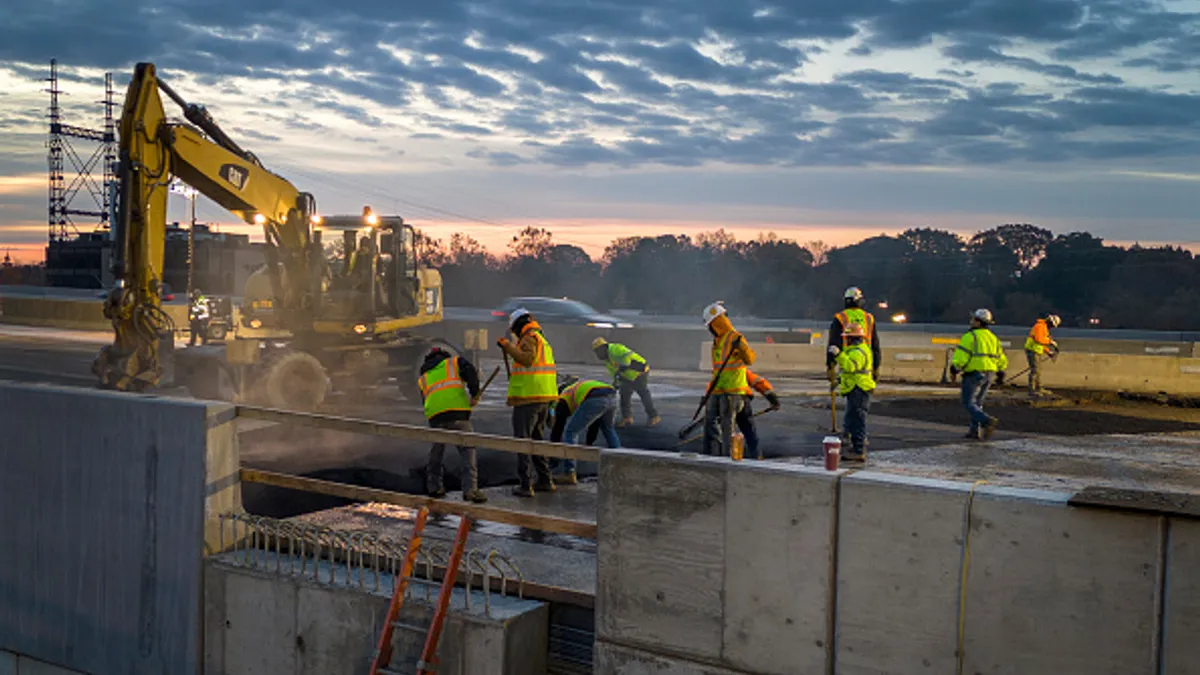This feature is a part of "The Dotted Line" series, which takes an in-depth look at the complex legal landscape of the construction industry. To view the entire series, click here.
Nearly two years into the the COVID-19 pandemic, construction attorneys say that material availability and skyrocketing prices are resulting in breach of contract claims, and the potential for construction defect issues years down the road.
"Claims for late project delivery are arising from the unavailability of necessary materials, supplies or components," said Matthew D. Harper, a member of the construction law practice at Eastman & Smith in Toledo, Ohio.
Those issues are impacting the relationships between owners and contractors, as well as causing friction between contractors and suppliers.
"In the last several months, we have seen an unprecedented spike in construction materials costs — from steel to lumber, insulation, solar panels, and everything in between — as well as related shortages," said Brenda Radmacher, a partner in the construction practice of the Akerman law firm in Los Angeles. "These have injected new tensions into business relationships in the construction industry."
Andrew Richards, chair of the construction practice group at Kaufman Dolowich & Voluck in New York, said the current environment includes project sponsors putting more pressure on construction firms to get the job done. "Owners are holding liquidated damages over the heads of contractors."
While the friction from delays is already playing out in the industry, attorneys are also worried about the impact the current conditions could have years from now in the form of construction defect claims due to material substitutions.
"We are anticipating that a rash of construction defect issues may arise on these projects," said Radmacher. "The limited construction material availability is impacting the construction sequencing and changes in the design that may very likely lead to disputes later on." That could be the case even when changes have been approved, she said.
It's on Harper's radar, too.
"Predicting the future is hard for everyone, lawyers included," said Harper. "But we can expect to see construction defect claims when contractors are forced to use materials, supplies, or components not originally specified for the project if the replacement later fails in some way."
Protecting yourself now
To protect themselves now, and limit the possibility of trouble in the future, construction law experts say contractors need to carefully review what's in their contracts today, while making sure there are provisions to cover unforeseen circumstances tomorrow. For example, specific language in contracts should cover material delays or a lack of available supplies.
"Most contracts, including the standard form AIA documents, allow for an extension of time for delays caused by things outside of the contractor's control, and supply chain issues typically count as an item outside of the contractor's control," said David Fine, a partner and chair of the construction law group at Massachusetts-based firm Mirick O'Connell. "Where contractors are running into breaches is in circumstances where this language has been modified, or where language has been added carving out exceptions for delays caused by 'market conditions,' 'supply chain impacts' or items of this nature."
For existing contracts that don't specifically cover these circumstances, all may not be lost — but your lawyers may have to work harder to protect you.
"The strategy that contractors are going to have to use is finding language that's already in there that generally addresses issues not specifically tailored to anything, and try and fit the situation into those provisions," said Jordan Nadel, a partner at Mark Migdal & Hayden in Miami. "If you have a general force majeure clause that talks about allowing for excusable delays due to unforeseen events, you're going to have to try and argue that the supply chain issues are captured within that provision."
Working it out together
Also working in contractors' favor is the fact that many owners won't have anyone else to turn to if they can't get their job done, with whatever materials are available, using the team they already have in place. In other words, because everyone is in the same boat, there's been more willingness to work these issues out.
"We are seeing some instances where all of the parties in the supply chain, including suppliers, fabricators, erectors, contractors and even owners are working cooperatively to absorb the price increases or the scheduling costs," Radmacher said.
Things are getting messy, though, when that let's-work-together approach wanes and owners push to get a job done.
"A real problem develops where the contractor is faced with the choice of potentially being held with liquidated damages if the original material to be installed is not available, but a more expensive material is available," Richards said. "The contract will most likely not give the contractor the right to a change order for the difference in cost."
In that case, you're back to trying to find a clause within the language of the contract that could apply.
Construction defect cases ahead
The true wildcard of what's happening today, however, will be the ramifications of what the shortages and delays mean, from a legal perspective, years in the future, if construction defect claims do occur.
To protect yourself against that possibility now, take the tried-and-true approach of recording every change in materials or schedule, and making sure they're approved down the line.
"Document, document, document," Radmacher said. "[Showing] the reasonable steps taken to ensure timely delivery and anticipating issues will be helpful and persuasive in defending construction defect claims."
Of course, you can't just record those actions in a vacuum. Keeping ownership in the loop as a situation progresses is also critical.
"Contractors should give timely and complete notice of those issues to the owner, along with an appropriate request for an extension of time or a change in the price," Harper said. "If a change is agreed to, make sure it is confirmed in a written, signed change order."
You also need to make sure that the appropriate parties within the engineering, design and construction chain give the go ahead for deviations from plan, especially when it comes to substituting an originally specified material.
"You really need to exercise an abundant amount of caution when doing something different than you initially planned to do," Nadel said. "Make sure you do a good job coordinating with the architect to make sure that it is, in fact, a suitable substitution."
If you don't, you'll likely own any undesirable outcomes that happen as a result.
"Deciding to use a replacement without such a change order means the contractor is taking the risk if it fails," said Harper.
Not the time to cut corners
Don't let the pressures of the day force you into cutting corners that you usually wouldn't, a situation that's more likely as contractors scramble to meet project deadlines while dealing with rising prices.
"Increased costs could result in lesser skilled labor being utilized because of their lower rates, or there could be utilization of inferior products and materials because of shortages," said Michelle M. Krone, co-chair of the construction practice group at Florida-based Kubicki Draper.
Especially problematic is when shortages force contractors to use materials they're not familiar with.
"Scarcity is a different problem that may lead to similar issues, where contractors are getting creative in order to substitute new and sometimes untested materials when the usual materials are not available," Fine said.
From that perspective, the best practice doesn't come down to contract language as much as it does good business, and making sure you're still doing your due diligence in these trying times.
"It's not really a legal thing, as much as it is general advice," Nadel said. "There's nothing wrong with dealing with suppliers you've never dealt with before. Contractors just want make sure that they're getting materials from reputable sources, and not doing anything or taking any risks that they shouldn't because they have their back up against the wall."
____________________________________________________________
The Dotted Line series is brought to you by AIA Contract Documents®, a recognized leader in design and construction contracts. To learn more about their 200+ contracts, and to access free resources, visit their website here. AIA Contract Documents has no influence over Construction Dive's coverage within the articles, and content does not reflect the views or opinions of The American Institute of Architects, AIA Contract Documents or its employees.





















